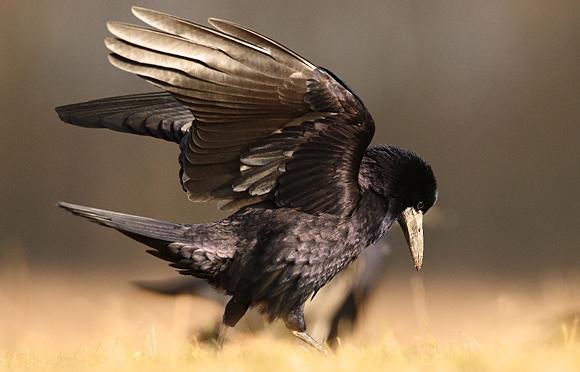Taxonomy
Kingdom | Animalia |
Phylum | Chordata |
Subphilum | Vertebrata |
Class | Aves |
Order | Passeriformes |
Family | Corvida |
Genus | Corvus |
Species | C. frugilegus |
Habitat
In Hungary it is very common. It flies in big groups. The main stock in Hungary is not vagrant, but many come from the north during autumn to spend winter here. It lives on open terrain close to water. Living in large flocks sometimes it causes an agricultural pest and in some countries is being eradicated.
Morphology
This species is 46cm long ad 81-99cm wingspan, showing a blue or bluish-purple sheen in bright sunlight. The feathers on the head, neck and shoulders are particularly dense and silky. The legs and feet are generally black and the bill grey-black.
Rooks are distinguished from similar members of the crow family by the bare grey-white skin around the base of the adult's bill in front of the eyes. The feathering around the legs also look shaggier and laxer than the congeneric Carrion Crow. The juvenile is superficially more similar to the Crow because it lacks the bare patch at the base of the bill, but it loses the facial feathers after about six months.
Diet
Food is predominantly earthworms and insect larvae, which the bird finds by probing the ground with its strong bill. It also eats cultivated cereal grain, smaller amounts of fruit, small mammals, acorns, small birds, their eggs and young and carrion. In urban sites, human food scraps are taken from rubbish dumps and streets, usually in the early hours when it is relatively quiet.
Habits
Nesting is always colonial, usually in the very tops of the trees. Branches and twigs are broken off trees (very rarely picked up off the ground), though as many are likely to be stolen from nearby nests as are collected from trees. Eggs are usually 3–5 in number, can appear by the end of February or early March and are incubated for 16–18 days. Both adults feed the young, which are fledged by the 32nd or 33rd day.
In autumn, the young birds of the summer collect into large flocks together with unpaired birds of previous seasons, often in company with jackdaws. It is during the autumn that spectacular aerial displays can be seen by adult birds that seem to delight in the autumn gales.
Role in the fields
Usually rooks would eat pest animals on the field, improving the harvest. However with modern chemicals overtaking this role rooks become more and more forced to put up with grains instead of insects, mice and other small animals that they would otherwise prefer. This is the root of animosity between rooks and man.
Nesting
Nesting is always colonial, usually in the very tops of the trees. Branches and twigs are broken off trees (very rarely picked up off the ground), though as many are likely to be stolen from nearby nests as are collected from trees. Eggs are usually 3–5 in number, can appear by the end of February or early March and are incubated for 16–18 days. Both adults feed the young, which are fledged by the 32nd or 33rd day.
Role in the ecosystem
Rooks are enemy No 1 in some agricultural areas. However, the result of the eradication process has revealed how complex the ecosystem is. Rooks breed in March and the young generation leaves the nest in May. The desolated nests get occupied by the Red-footed Falcon (Falco vespertinus), provided that those nests are there and not disturbed by agriculture. They have been disturbed and the red-footed falcon became a became an item on the IUCN Red List classified as near threatened.
Endangeredness
This species has a large range, with an estimated global extent of occurrence of 10,000,000 km². It has a large global population, including an estimated 20,000,000-35,000,000 individuals in Europe. The species is not believed to approach the thresholds for the population decline criterion of the IUCN Red List (i.e. declining more than 30% in ten years or three generations). For these reasons, the species is evaluated by the IUCN as Least Concern.
In Hungary there is more concern about the bird. The man destroys their nests, strays pesticides on certain locations to eradicate mice and rooks eat them. In 2001 rooks gained an officially protected status in Hungary.
Mező növény és állatvilága − http://www.tananyag.almasi.hu/krez/a_mezo/madar/varju.htm
Wikipédia − http://hu.wikipedia.org/wiki/Vetési_varjú
Sulinet − http://sdt.sulinet.hu/Player/Default.aspx?g=958367e7-d1a0-4e7f-8e68-51746460d122&cid=64950b5c-ea63-4acb-8218-86830516e8e4
National Geographic − http://www.geographic.hu/Termeszet/2009/01/Eljott_a_varju_eve
Képek-Origo − http://www.origo.hu/tudomany/20090114-furcsa-par-a-kek-vercse-es-a-vetesi-varju-az.htmlhttp://en.wikipedia.org/wiki/Rook_(bird)http://www.iucnredlist.org/apps/redlist/details/146656/0
